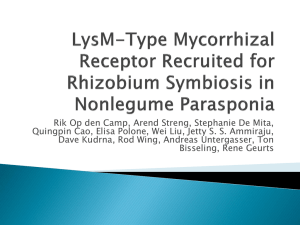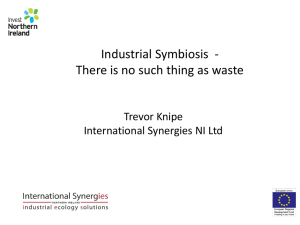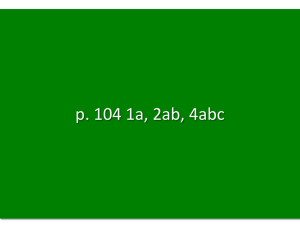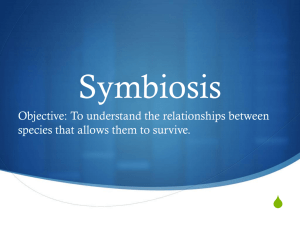Azolla
advertisement
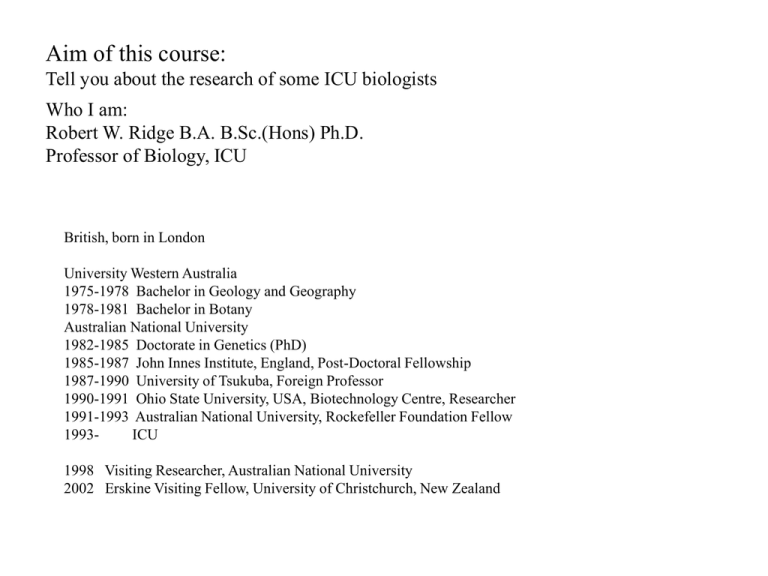
Aim of this course: Tell you about the research of some ICU biologists Who I am: Robert W. Ridge B.A. B.Sc.(Hons) Ph.D. Professor of Biology, ICU British, born in London University Western Australia 1975-1978 Bachelor in Geology and Geography 1978-1981 Bachelor in Botany Australian National University 1982-1985 Doctorate in Genetics (PhD) 1985-1987 John Innes Institute, England, Post-Doctoral Fellowship 1987-1990 University of Tsukuba, Foreign Professor 1990-1991 Ohio State University, USA, Biotechnology Centre, Researcher 1991-1993 Australian National University, Rockefeller Foundation Fellow 1993ICU 1998 Visiting Researcher, Australian National University 2002 Erskine Visiting Fellow, University of Christchurch, New Zealand Lecture outline Lecture 1 Introduction Lecture 2 The role of nitrogen in the planet The phenomenon of the Rhizobium legume symbiosis Lecture 3 Basic cell biology – how the cell works Lecture 4 What I have studied and researched Lecture 5 Root hairs and experiments Lecture 6 Root hairs and experiments Lecture 7 Gene transfer by Agrobacterium as a tool in research (Prof Williamson) REPORT Details later Research Field: The biology of root hairs What is a root hair? White clover , Trifolium sp. Arabidopsis mutant Vicia sp. Research Field Contexts: Agriculture - because I work on legumes, a major crop Symbiosis - because legumes have an intimate interaction with a soil bacterium called Rhizobium, which invades the plant via the root hair Pure Cell Biology - because I study the root hair as a model plant cell Agriculture Crop rotation Hundreds of years ago farmers knew that some crops would put “goodness” into the soil, and others would remove it. They soon realised that if they grew cereal crops the year after peas or beans, then they would get a better yield. Growing the same vegetables in the same spot each year can lead to problems. Soil living pests and diseases, which thrive on that particular crop, can build up in the soil to epidemic levels. Vegetables also have various mineral needs and continuous cropping of one particular crop can lead to the levels of nutrients in the soil becoming unbalanced. To prevent the build up of pests and diseases in the soil and to help the vegetables in their nutrient needs, crops need to be rotated. Vegetables grow better in soil that has been previously used for a different crop, than in soil that has been used for one of their own kind. It didn’t take farmers long to recognise that legumes have a distinct advantage, and the crops after legumes grew much better. Farmers and early agriculturalists knew that legume roots had strange lumps on them, which they called nodules, but it wasn’t until late in the 19th Century that scientists could show that these nodules had a direct conenction with the excellent growth of legumes in poor soils. I will return to legumes and Rhizobium in a later class. But remember that legumes are an important part of your diet, and in some parts of the world form the basis of diet, because they can grown on poor soils and are high in protein. What legumes do you eat every day? Symbiosis Living together. Originally termed by de Bary for any intimate relationship between two different organisms. Symbiosis can be divided into three kinds of relationship a. commensalistic (commensalism) one partner living on the other with no obvious effect on the second (literally: eating at the same table). Eg cockroaches in our houses, shrimps on crabs, epiphytic plants (see tree by library north facing side). There are thousands of examples ! b. mutualistic (mutualism, symbiosis) : advantages for both partners cleanerfish: get food, cleaned fish avoids parasites and disease; ants cultivate caterpillars and aphids for honey which are protected by the ants; termites have obligate symbiosis with protozoa, ruminants have obligate symbiosis, so do humans with E. coli. Plant symbiosis not so obvious, and often involves the element Nitrogen. Rhizobium/legume Azolla/blue-green alga Gunnera/blue-green alga Frankia/Alnus Mycorrhizae help in nutrient uptake c. pathogenic (parasitism, antagonism) : One partner living on the other with detrimental effect on the second Leaf Rust MOST ancient symbiosis was the incorporation of a prokaryotic cell (ie a bacteria-like ancestor) into another primitive organism, to make the ancestor of the eucaryotic cell (the kinds of cells that we and all higher organisms are made up of). I want to explain some plant symbioses to you, so that you get the general idea, and then in a later lecture describe one symbiosis, the Rhizobium legume symbiosis, in much more detail. Gradually I will narrow down to my research topic. This background information is very important for you to understand why I do research on my particular topic. Now I will discuss briefly each of the following: Lichen/blue-green alga (fungus and plant) Azolla/blue-green alga (plant and plant) Gunnera/blue-green alga (plant and plant) Rhizobium/legume (bacteria and plant) Frankia/Alnus (bacteria and plant) Mycorrhiza (fungus and plant) LICHEN !!! LICHENS: commensalism Mycobiont: an ascomycete Plant: an alga Organic carbon from alga via “haustoria” which penetrate algal cell wall Alga have protection from dessication Anabaena (Nostoc) and the Azolla Symbiosis Cyanobacteria, with the ability to both photosynthesize and fix N2, are ideal pioneering species. However, some occur in symbiosis with a host including lichenous fungi, liverworts such as Blasia, the aquatic fern Azolla, and the angiosperm Gunnera. Of these, Azolla is the most commercially important. Traditionally Azolla is maintained and propogated in slow-flowing creeks or overwintered in protected beds, then introduced into paddies between plantings of rice. The fern can then be either incorporated before rice seedlings are transplanted, or left to be shaded out as the rice canopy develops. Yields in the subsequent rice crop are enhanced by up to 1000 kg ha-1. http://waynesword.palomar.edu/plnov98.htm A dorsal lobe of the water fern Azolla showing the dark-green pocket filled with cells of the microsymbiont Anabaena (Nostoc) azollae. A filament of the cyanobacterial microsymbiont (Anabaena [Nostoc] azollae) showing both enlarged heterocysts and normal cells of the micro-symbiont. Heterocyst frequency is greater than 20%. Gunnera sp. Botanic Gardens, Christchurch, NZ Gunnera - the only angiosperm that has a symbiosis with a blue-green alga Gunnera chilensis stem. Scales normally covering the stem are removed. Glandular tissue where symbiotic interaction with Nostoc occur are numerous. Cross-sectioned stem from Gunnera chilensis in light microscope, showing Nostoc colonies in Gunnera symbiotic tissue beneath a stem gland. Nostoc http://www.botan.su.se/fysiologi/Cyano/Sub-1.htm Frankia and the Actinorhizal Symbiosis. Frankia is an actinomycete forming N2fixing (actinorhizal) nodules with a range of angiosperms. Frankia is a Gram-positive, filamentous organism characterized by multilocular sporangia and N2fixing vesicles in vitro. Vesicle production occurs under conditions of N limitation, and in the nodule, mature vesicles have a pronounced lipid envelope that protects the nitrogenase from oxygen. In the symbioses in which vesicles are not formed (eg. Casuarina), lignification of infected and adjacent cells results in formation of an oxygen diffusion barrier. Strains of Frankia form root nodules on eight families of dicotylenous plants (Betulaceae, Casuarinaceae, Coriariaceae, Datiscaceae, Elaeagnaceae, Myricaceae, Rhamnaceae and Rosaceae). Infection is via root hairs in some genera (Casuarina, Myrica), but proceeds intracellularly in others (Discaria, Dryas, Ceanothus). Nodules are perennial modified lateral roots with lobes up to 5 cm in length. Alnus glutinosa - there are examples on ICU campus Alnus nodules Mycorrhizae http://www.blm.gov/nstc/soil/fungi/ Mycorrhizae are symbiotic soil fungi, present in most soils, that attach themselves directly onto the roots of most plants. They help the host plants absorb more water and nutrients while the host plants provide food for the fungi. Because the surface area of the hyphae, the feeding structures of the mycorrhizae, may be several hundred times the surface area of the roots, the mycorrhizae can feed on a larger soil mass than the roots and they do so more thoroughly. Mycorrhizae have the potential to be a central nutritional source for the host plant. There are two basic types: ectomycorrhizae that associates on the plant surface only, and endomycorrhizae, which can enter the plant cells. One particular type is called VAM, Vesicular Arbuscular Mycorrhizae. Jack pine mycorrhizae VAM fungi Redwood trees grown without and with mycorrhiza Mycorrhizal fungi enhance phosphorus uptake of their host plants and their presence is more prevalent in roots in low P soils. Mycorrhizas also increase the uptake of other mineral nutrients such as Cu and Zn. Mycorrhiza formation has also been shown to confer drought and disease resistance, reduce pest damage and nematode infection, promote seed production, and increase the fitness of plant offspring. The Symbiosis Between Legumes and Rhizobia Legumes have been used in crop rotations since the time of the Romans. However, it was not until detailed N balance studies became possible, that they were shown to accumulate N from sources other than soil and fertilizer. In 1886 Hellriegel and Wilfarth demonstrated that the ability of legumes to convert N2 from the atmosphere into compounds which could be used by the plant was due to the presence of swellings or nodules on the legume root, and to the presence of particular bacteria within these nodules. There are different types of root-nodule bacteria; but for the moment can refer to them collectively as rhizobia. The first rhizobia were isolated from nodules by Beijerinck in 1888, and shown to have the ability to reinfect their legume hosts, and to fix N2 in symbiosis. Koch’s Postulate. http://waynesword.palomar.edu/trmar99.htm#rootnodule Cell characteristics of Bradyrhizobium japonicum. The cell measures approximately 2µm x 1µm. Soybeans : plus and minus Rhizobium Section through a nodule to show rhizobia-filled cells Lots of red nodules ! Minus rhizobia Plus rhizobia
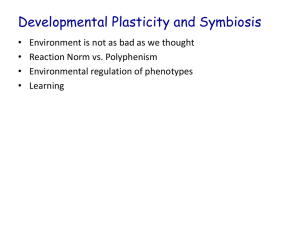
![Symbiosis[1]](http://s2.studylib.net/store/data/005449742_1-2c9de7b7b178f521480e9109673f342e-300x300.png)
